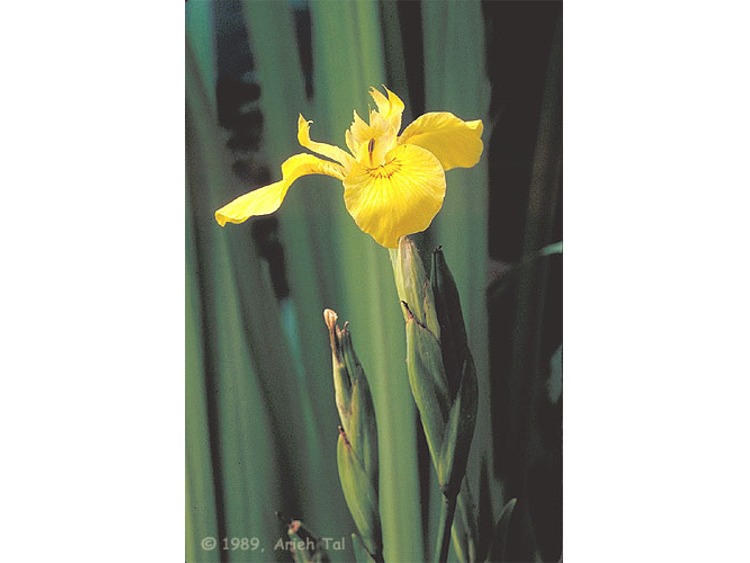Iris pseudacorus Pictures
Scientific Name: Iris pseudacorus (yellow flag iris) (5)

Family Name: Iridaceae (5)
Description: The plant is 4-6 ft. in height, and are spaced from about 36-48 in. apart. The plant is the only yellow iris in the United States. The yellow flag iris has a robust stalk, and the plant has a long blooming season. (2, 5)
Roots: The roots of the yellow flag iris are 10-30 cm long. (5)
Stems/Leaves: The yellow flag iris is a tall plant with long, dark green, flattened, sword like leaves. The leaves can grow up to 2.5 cm wide. The leaves also arise usually longer than the stem. (3, 5)
Flowers: The size of the flower is 3-4 inches across, and is yellow. The flower is 8-10 cm in diameter. It has 3 sepals that are backward curving and non bearded. The flower time is from June-August. (3, 5)
Fruits/Seeds: The fruit of this weed is oblong and capsule-like and also usually 2" long. (5)
Methods of Reproduction/Spread: The plant is slowly spread and easily contained. It is spread by the wind and water. The wind catches the seed and blows it into the water and the water carries it downstream to its new home. (5)
Life Styles/Habits/Life Duration: Perennial (2)
Environments Favorable to infestation: Yellow-flag-iris will continue to spread as long as it is being sold in stores and nurseries, and also it will move down stream just by the seeds and plant parts. (8)
Impacts: Yellow-flag-iris is a fast growing and fast spreading weed. It creates thickets in water just like cattails. (9)
Native Range/probable entry into N. America: It is native to Europe, British Isles, North Africa and the Mediterranean region; unfortunately yellow flag iris is sold over the internet on gardening web sites. Yellow-flag iris entered the U.S. from Canada as an ornmental plant in the early 1900's. (7)
Montana Infestation/History: Rare, North Western Montana.
Methods of Control: One of the most useful ways to control this plant is to use chopping machines that destroy the bulbs/roots. There is no biocontrol for this species at this time. Animals seem to eat yellow flag iris with their hay and other foods out in the wild. (6)
How to Prevent the Spread: No data available.
Habitat: Yellow flag iris lives along stream beds, near ponds, and in marshes. (5)
Links:
http://plantsdatabase.com/go/666/
http://www.acclaimstockphotography.com/_gallery/_pages/0028-0401-2417-1307.html
http://nature.org/wherewework/northamerica/states/ohio/science/art7050.html
http://dnr.metrokc.gov/wlr/lands/weeds/iris.htm
http://en.wikipedia.org/wiki/Yellow_flag
http://www.co.stevens.wa.us/weedboard/other%20weeds/yellow%20flag%20iris.htm
http://www.enature.com/fieldguide/showSpeciesRECNUM.asp?recnum=WF0162
http://www.laurentiancenter.com/plantkey/plants/irisyellowflag.html
http://aquat1.ifas.ufl.edu/seagrant/iripse2.html
http://wildflowers.jdcc.edu/Yellow%20Iris.html
Sources:
1. "yellow flag iris." Perennials on parade. 3/16/04. Kurt Weiss Greenhouse, Inc.. 3/16/04 <http://kurtweiss.com/products/perennial/yellow.html>.
2. "yellow flag iris." Non-Native Invasive Aquatic Plants in the United States. 3/16/04. Center for Aquatic and Invasive Plants. 3/18/04 <http://aquat1.ifas.ufl.edu/seagrant/iripse2.html>.
3. . "Skye Flora." Yellow Flag. April 7, 2003. Photo @ Carl Farmer. 3/11/04 <http://www.plant-identification.co.uk/skye/iridaceae/iris-pseudacorus.htm>.
4. . "Yellow Iris (Yellow Flag)." Connecticut Botanical Society. Feb. 15, 2003. Connecticut Wildflowers. 3/11/04 <http://www.ct-botanical-society.org/galleries/irispseu.html>.
5. "Wildflowers." enature.com. . National Wildlife Federation. 3/10/04 <http://www.enature.com/fieldguide/showSpeciesRECNUM.asp?recnum=WF0162>.
6. University of Florida Aquatic Weed Management Guide, Vandiver 1999 http://aquat1.ifas.ufl.edu/seagrant/iripse2.html.
7. Cody WJ. 1961. Iris pseudacorus L. escaped from cultivation in Canada. Canadian Field Nat., 75: 139-142.
8. No author found. <http://aquat1.ifas.ufl.edu/seagrant/iripse2.html>.
9. Falinska K. 1986. Demography of Iris pseudacorus L. populations in abandoned meadows. Ekol. Polska 34(4):583-613, <http://aquat1.ifas.ufl.edu/seagrant/iripse2.html>.
By: Zac & Layne 03/04. Updated By: Ben Foster 3/1/07.
Back to Weed ID mtwow.org HOME